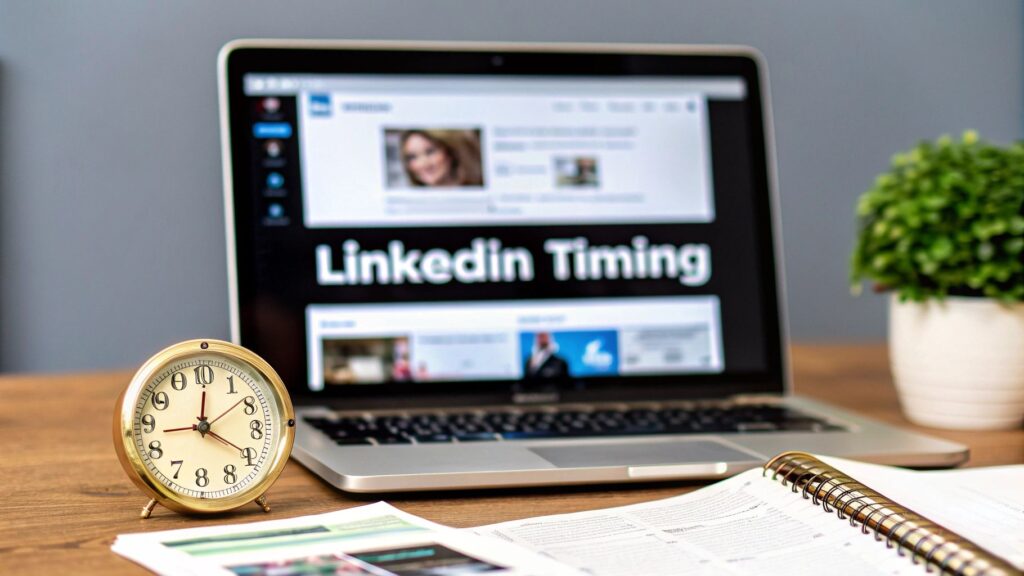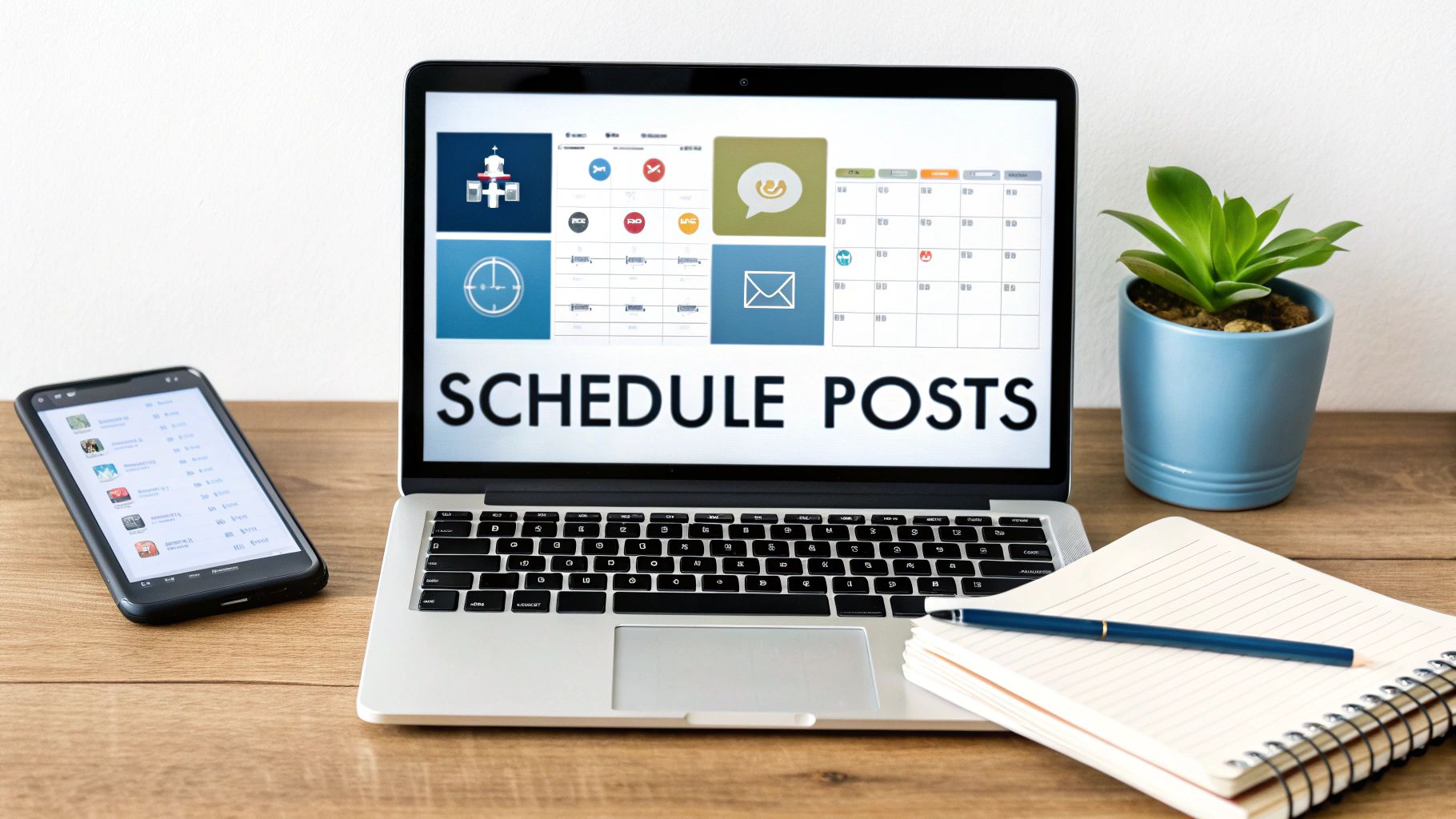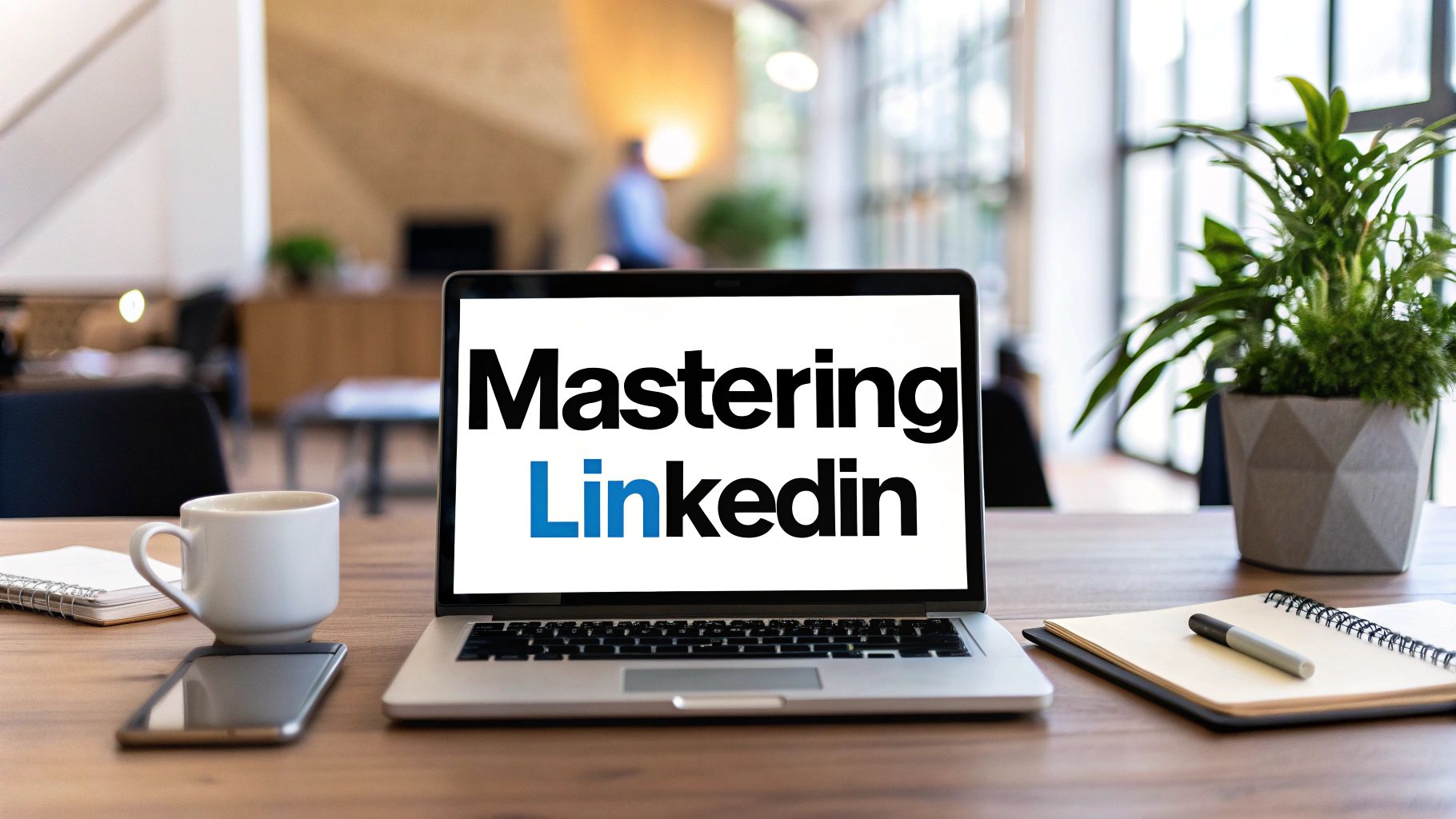In the crowded professional landscape of LinkedIn, exceptional content is only half the battle. The other half is timing. Posting when your audience is most active can be the difference between your insights sparking a viral conversation and them disappearing into the digital void. While countless guides offer generic advice, the true best time to post on LinkedIn depends on a blend of broad, data-backed trends and your unique audience's behaviour.
This guide cuts through the noise, providing seven actionable, data-driven strategies to pinpoint the optimal windows for your content. We will move beyond vague suggestions and delve into specific time slots, day-of-the-week performance, and the critical importance of tailoring your schedule to your target industry and geographical location. To truly master your posting schedule, a deeper understanding of the platform's mechanics is essential. Learn more about understanding the LinkedIn algorithm to ensure your carefully timed posts achieve maximum reach and impact.
Here, you will discover peak engagement periods, industry-specific nuances, and how to use analytics tools like Trustypost to move from guesswork to a predictable, high-impact posting schedule that drives meaningful results and genuine professional connections.
1. Post During Peak Weekday Business Hours
The most foundational strategy for determining the best time to post on LinkedIn is to align your content schedule with standard business hours. For most professionals, LinkedIn is an integrated part of their workday, not a platform for evening leisure. This means a significant portion of users are most active during the traditional 9 AM to 5 PM window on weekdays, particularly from Tuesday to Thursday. This period is when they are at their desks, actively seeking industry insights, networking with peers, and engaging with professional content.
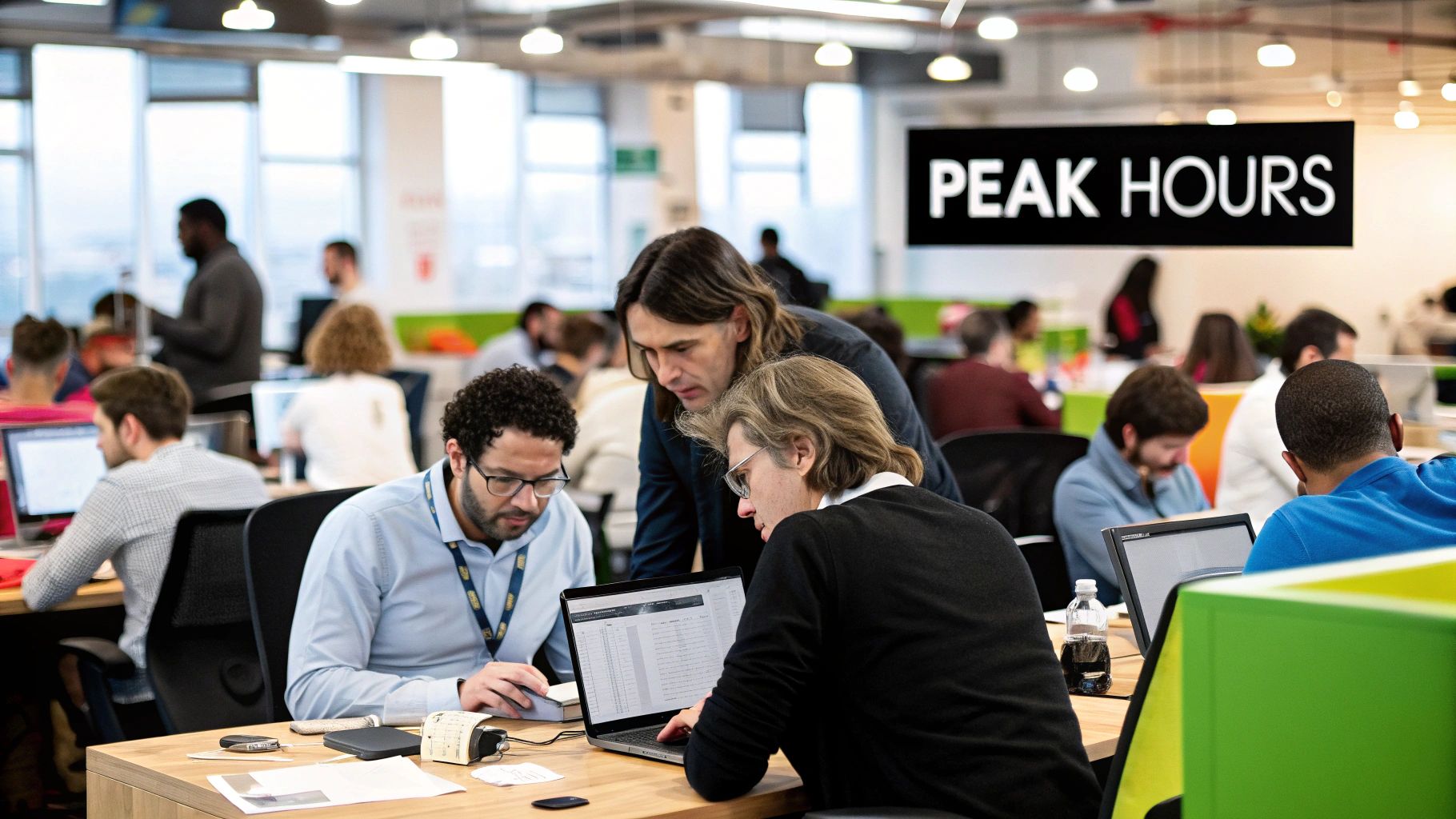
Publishing during these peak hours maximises your content's initial visibility. The LinkedIn algorithm prioritises posts that generate immediate engagement, so reaching your audience when they are most likely to like, comment, and share gives your content the momentum it needs to achieve a wider reach.
Why This Strategy Works
This approach is effective because it targets users in a professional mindset. Unlike other social media platforms used for entertainment, LinkedIn's primary function is career and business development. Content posted during working hours directly enters this professional context, making it more relevant and likely to be consumed by an audience looking for valuable industry-specific information.
Key Insight: Aligning your posting schedule with the professional workday capitalises on user intent. Audiences are actively seeking valuable content and are primed to engage with posts that offer solutions, insights, or career-related discussions.
Real-World Examples of Peak-Time Posting
Several industry leaders consistently leverage this strategy to great effect:
- HubSpot: The marketing software giant often shares its educational blog posts and guides around 10 AM EST on Tuesdays, catching professionals as they settle into their work week.
- Microsoft: This tech leader frequently publishes thought leadership pieces and company news around 2 PM PST on Wednesdays, targeting the mid-afternoon productivity window on the West Coast.
- Salesforce: Data from their own marketing efforts shows that posts published between Tuesday and Thursday receive up to 40% higher engagement compared to those shared over the weekend.
How to Implement This Strategy
To effectively leverage peak business hours, follow these actionable steps:
- Pinpoint Your Audience's Time Zone: If your audience is global, analyse your LinkedIn Analytics to identify the primary time zones of your followers. Prioritise the time zone with the highest concentration of your target demographic.
- Test Mid-Morning and Mid-Afternoon Slots: Start by scheduling posts at 10 AM and 3 PM in your target time zone. These times often correspond with pre-lunch and post-lunch browsing habits.
- Analyse Your Results: Use Trustypost’s analytics to track which specific hours within the 9 AM to 5 PM window deliver the highest reach and engagement rates for your content. Look for patterns over a few weeks to identify your unique sweet spot.
- Schedule in Advance: Use a scheduling tool to plan your content, ensuring it goes live consistently during these optimised windows without requiring manual posting. This helps build an expectation with your audience.
2. Leverage the Tuesday-Thursday Sweet Spot
While posting during general business hours is a strong starting point, data consistently reveals a more refined window of opportunity within the work week. Tuesday, Wednesday, and Thursday typically generate the highest engagement rates on LinkedIn. This three-day period represents the peak of professional focus, when users have settled into their weekly rhythm and are most actively seeking industry content, networking, and career development insights.
Mondays are often spent catching up on emails and planning, while Fridays see attention shift towards wrapping up tasks and preparing for the weekend. The mid-week sweet spot, from Tuesday to Thursday, captures your audience when they are most receptive and mentally present on the platform. Posting during this time significantly increases the likelihood of your content being seen and engaged with.
Why This Strategy Works
This approach is effective because it aligns with established professional workflows and psychological patterns. By mid-week, the initial rush of Monday is over, and professionals are deeply engaged in their core responsibilities. They turn to LinkedIn for solutions, industry news, and valuable discussions that can inform their work, making content published on these days more relevant and timely.
Key Insight: The Tuesday to Thursday period is the professional prime time. Users are not just logged in; they are actively participating, making it the ideal window to publish your most valuable and thought-provoking content for maximum impact.
Real-World Examples of Mid-Week Dominance
Numerous studies and industry practices confirm the power of this mid-week window:
- LinkedIn's Own Research: Internal data from LinkedIn has shown that content published on a Wednesday can see up to 70% higher engagement compared to posts on other days.
- Buffer's Analysis: A comprehensive study by Buffer revealed that Tuesday posts received 23% more clicks, indicating a higher intent to consume long-form content and visit external links.
- Hootsuite's Findings: Hootsuite reports that Wednesday posts are shared 40% more often, demonstrating that mid-week content is more likely to be deemed valuable enough to share with a user's own network.
How to Implement This Strategy
To capitalise on the mid-week peak, follow these actionable steps:
- Prioritise Your High-Value Content: Schedule your most important posts, such as thought leadership articles, major announcements, or detailed case studies, for Wednesday to capture peak attention.
- Structure Your Week: Use Tuesday for sharing industry insights or asking engaging questions to start conversations. Reserve Thursday for company updates, job postings, or event promotions. This creates a consistent rhythm for your followers.
- Validate with Your Own Data: While the trend is strong, use Trustypost’s analytics to confirm this pattern holds true for your specific audience. Check which of these three days consistently delivers the best results for you.
- Integrate into Your Planning: When building your social media content strategy, consciously allocate your best content ideas for Tuesday, Wednesday, and Thursday to ensure you are always publishing during the highest-potential windows.
3. Optimize for Morning Engagement (8-10 AM)
Capitalising on the early morning window, specifically between 8 AM and 10 AM in your audience's primary time zone, is a powerful strategy to maximise engagement. This period captures professionals as they begin their workday. Many users check LinkedIn first thing to catch up on industry news, view updates from their network, and set a productive tone for the day ahead, making it a prime opportunity for your content to be seen.

Posting during this timeframe allows your content to be one of the first things your audience sees. This immediate visibility can lead to a surge in initial likes and comments, which signals to the LinkedIn algorithm that your post is valuable, thereby boosting its reach throughout the rest of the day.
Why This Strategy Works
This approach is effective because it targets users when they are most focused and receptive. Before the day's meetings and tasks fully take over, professionals are often in a content consumption mindset. Posting content that is motivational, educational, or provides a quick industry insight aligns perfectly with this morning routine, making it more likely to resonate and drive engagement.
Key Insight: The 8-10 AM window targets users during their peak productivity kick-off. Content shared during this time becomes part of their daily professional check-in, leading to higher initial engagement and sustained visibility.
Real-World Examples of Morning Posting
Many influential figures and brands have mastered the art of morning engagement to achieve consistent results:
- Gary Vaynerchuk: The entrepreneur consistently posts around 8:30 AM EST, capturing his audience as they start their day and are looking for motivation and business insights.
- Simon Sinek: The renowned author and speaker often shares his thought leadership content around 9 AM, a time when professionals are actively seeking inspiration to guide their work.
- Adobe: The software giant's B2B content has been shown to perform up to 45% better when published at 9 AM compared to later in the afternoon, demonstrating the power of this morning window.
How to Implement This Strategy
To effectively leverage the morning engagement window, follow these actionable steps:
- Confirm Your Audience's Time Zone: Use your LinkedIn Analytics to identify where the majority of your followers are located. All scheduling should be based on their primary morning hours, not your own.
- Test Specific Morning Slots: Experiment by posting at 8 AM, 9 AM, and 10 AM on different days. Analyse which time slot consistently delivers the best performance for your unique audience and content type.
- Align Content with a Morning Mindset: Create content that is well-suited for the start of the day. This could include quick tips, motivational quotes, industry news roundups, or thought-provoking questions to spark discussion.
- Use a Scheduling Tool: Consistently hitting this early window can be challenging. Use a tool like Trustypost to schedule your content in advance, ensuring you never miss the opportunity to engage your audience at the optimal time.
4. Test Lunchtime Windows (12-1 PM) Strategically
While conventional advice often steers clear of lunch hours, a strategic approach reveals a valuable opportunity. For many professionals, the 12 PM to 1 PM window is a time to step away from intensive work and catch up on social media, including LinkedIn. This brief period can be an ideal time to capture your audience's attention with content that is engaging and easy to consume during a mental break.
This counter-intuitive timing can be particularly effective for personal stories, thought-provoking questions, or lighter professional topics that don't require deep concentration. The key is to match the content's tone to the audience's midday mindset, offering a welcome and valuable pause in their busy schedule.
Why This Strategy Works
This approach capitalises on a shift in user behaviour. During their lunch break, professionals are often browsing on their mobile devices, looking for a quick and engaging distraction from their workload. Content that is visually appealing, concise, and sparks a personal connection can perform exceptionally well, standing out from the more formal content that dominates the morning and afternoon feeds.
Key Insight: The best time to post on LinkedIn isn't always during peak productivity hours. By posting during the lunch break, you can connect with your audience when they are more relaxed and receptive to personal or less formal professional content.
Real-World Examples of Lunchtime Posting
Several brands and influencers have found success by targeting this specific window:
- Amy Porterfield: The personal branding expert often posts compelling personal stories or behind-the-scenes content around 12:30 PM, which resonates strongly with her audience as they take their midday break.
- SaaS Companies: Some software firms have reported a 15% higher engagement rate on more casual content, like company culture posts or team highlights, when shared during the lunch hour.
- Career Coaches: Many coaches find that job seekers are particularly active during their lunch breaks, making it a prime time to share quick career tips, motivational posts, or polls about workplace challenges.
How to Implement This Strategy
To test and leverage the lunchtime window effectively, follow these actionable steps:
- Select the Right Content: Choose content that is easy to digest. Personal anecdotes, engaging questions, quick video clips, or visually-driven posts are ideal. Avoid dense, data-heavy articles that require significant focus. For more ideas on post types, you can find a helpful guide on crafting the perfect LinkedIn post on trustypost.ai.
- Optimise for Mobile: Since most users will be on their phones, ensure your visuals are clear and your text is concise and easy to read on a small screen. Use short paragraphs and bullet points.
- Monitor Engagement Patterns: Use Trustypost's analytics to track if your audience shows an uptick in activity between 12 PM and 1 PM. Look for higher likes and comments on posts scheduled during this time.
- Test and Refine: Experiment with posting at different times within the hour, such as 12:15 PM or 12:45 PM, to see what works best for your specific audience's break habits.
5. Avoid Late Friday and Weekend Posting
Just as important as knowing when to post is knowing when not to post. For most professionals, LinkedIn engagement drops significantly after 3 PM on Fridays and remains low throughout the weekend. This is because the platform's core audience disengages from their professional mindset, shifting their focus to personal time and leisure activities, making the weekend generally a poor time to post on LinkedIn for maximum impact.

While the LinkedIn feed is chronological, the algorithm prioritises fresh content with strong initial engagement. Posting during these off-peak hours means your content is less likely to receive the immediate interaction needed to gain momentum. By the time your audience returns on Monday morning, your post will be buried under a weekend's worth of newer content.
Why This Strategy Works
This strategy is effective because it respects the natural work-life rhythm of the majority of LinkedIn users. By avoiding periods when your audience is mentally "checked out" from professional concerns, you ensure your high-value content is saved for moments when it will be most appreciated and engaged with. This prevents your efforts from being wasted on an inactive audience and concentrates your impact during high-traffic windows.
Key Insight: Understanding the typical work-week cycle is crucial. Avoiding low-traffic periods like late Fridays and weekends maximises the return on your content creation efforts by aligning publication with peak user attention.
Real-World Examples of Off-Peak Avoidance
Observing major brands reveals a clear pattern of avoiding these low-engagement slots:
- Fortune 500 Companies: A broad analysis often shows that posts from top corporations see as much as a 70% lower engagement rate on weekend posts compared to their weekday content.
- B2B Software Firms: Many companies in this sector report that posts published after 3 PM on a Friday receive up to 50% fewer views, as their target audience of business professionals has already begun to wind down for the weekend.
- Exception for Niche Audiences: In contrast, some entrepreneur-focused content creators may see modest weekend engagement from side-hustlers and individuals using weekends for professional development, highlighting the need to analyse your specific audience.
How to Implement This Strategy
To strategically avoid low-engagement windows, follow these clear steps:
- Confirm Your Audience's Pattern: Use your LinkedIn or Trustypost analytics to verify if your followers' activity drops off on Fridays and weekends. Most will, but it is always wise to confirm this with your own data.
- Repurpose Weekend Time: Instead of posting, use this quieter time for content planning, creation, and scheduling for the upcoming week. This turns a low-engagement period into a productive one.
- Opt for Lighter Friday Content: If you must post on a Friday afternoon, consider sharing lighter, more culture-focused, or celebratory content that is less demanding and fits the end-of-week mood.
- Prioritise Monday Morning: Save your most impactful announcements or thought leadership pieces for Monday morning. Your audience will be catching up on industry news and will be highly receptive to fresh content.
6. Account for Global Time Zones and International Audiences
For businesses and professionals with a geographically diverse follower base, the "best time to post on LinkedIn" is not a single slot but a series of strategic windows. Relying on a single time zone can mean missing huge segments of your audience who are asleep or offline. The key is to analyse where your audience is located and schedule content to reach key markets when they are most active, which often means posting more than once a day or finding optimal overlap periods.
This bar chart illustrates the two primary windows where content can capture significant engagement across multiple international regions simultaneously.
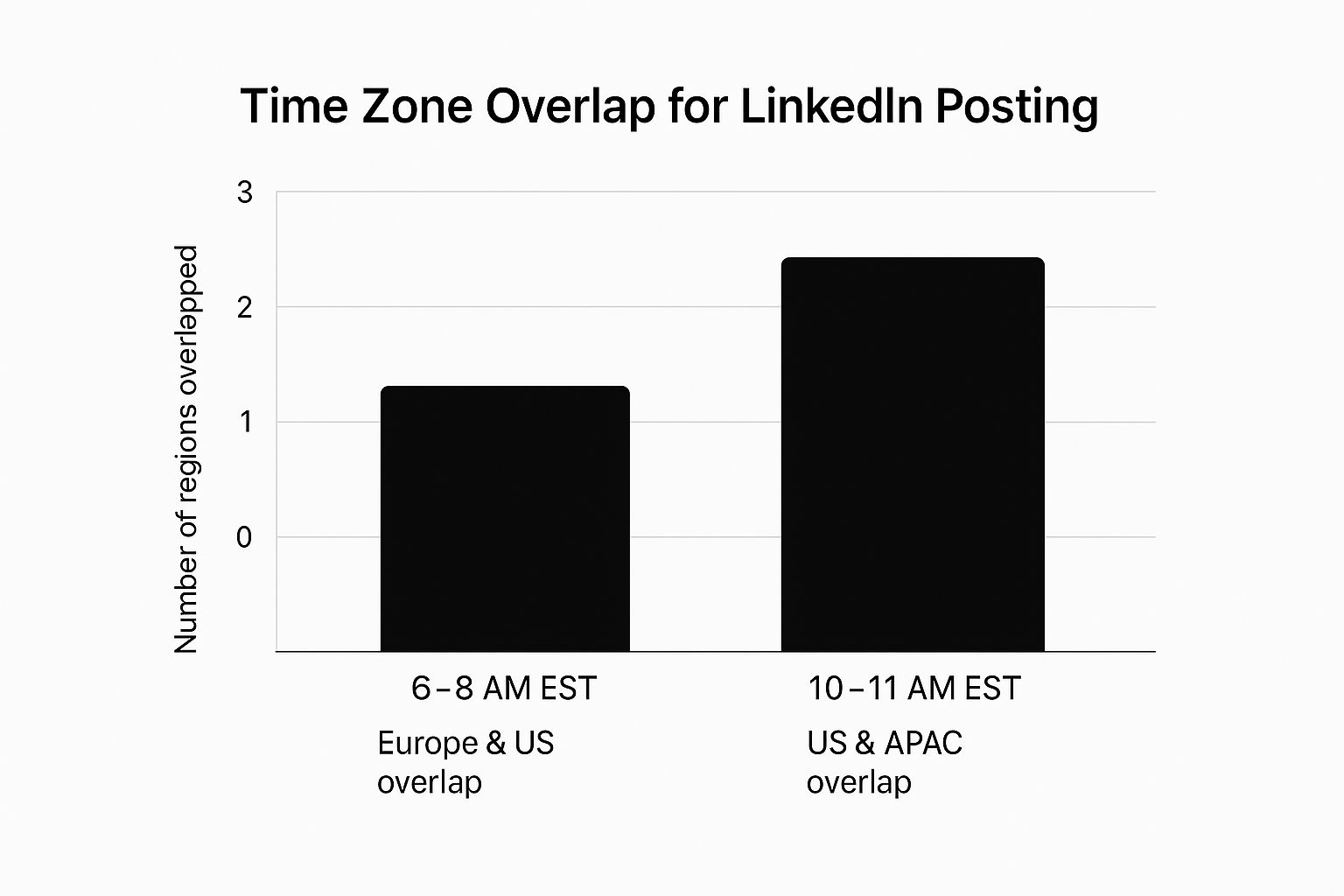
The chart highlights that posting in the early EST morning effectively captures both the North American and European workdays, while a later EST morning post can engage audiences across the US and the Asia-Pacific region.
Why This Strategy Works
This approach acknowledges that LinkedIn is a global platform. By tailoring your posting schedule to different time zones, you ensure your content is delivered to each segment of your audience during their respective peak business hours. This maximises initial visibility and engagement across the board, signalling to the LinkedIn algorithm that your content is valuable to a broad audience and deserves wider distribution.
Key Insight: A global posting strategy demonstrates a commitment to your entire audience, not just your local one. It expands your reach and engagement potential by meeting followers where they are, in their own workday rhythm.
Real-World Examples of Global Posting
Many multinational organisations have mastered this time-zone-centric approach:
- Microsoft: Often posts crucial updates around 6 AM EST to simultaneously reach its European audience in their early afternoon and catch early-rising professionals on the US East Coast.
- Global Consulting Firms: Companies like McKinsey & Company frequently publish content twice a day, once for the US/EMEA markets and a second time optimised for the APAC region, ensuring comprehensive coverage.
- International B2B SaaS Companies: Many have found success with a 1 PM GMT posting window, as it serves as a central point that overlaps with the end of the day in some parts of Asia, mid-day in Europe, and the start of the day in the Americas.
How to Implement This Strategy
To effectively manage a global content schedule, follow these steps:
- Identify Top Geographical Segments: Use your LinkedIn Analytics to navigate to the "Followers" tab and review the demographic data. Pinpoint the top 3-5 countries or regions where your followers are based.
- Find Optimal Overlap Windows: Identify 2-3 posting times that cover your key markets. For example, 7 AM EST is great for reaching North America and Europe, while 7 PM EST can effectively reach audiences in both North America and Oceania.
- Consider Cultural Nuances: Be aware that standard business hours and work weeks can vary. For instance, in some Middle Eastern countries, the work week runs from Sunday to Thursday. Tailor your schedule accordingly.
- Test and Analyse by Region: Post the same piece of content at different times to target different regions. Use Trustypost's analytics to compare engagement rates and identify which time slot works best for each geographical segment.
7. Use Data Analytics to Find Your Audience's Unique Patterns
While general guidelines provide an excellent starting point, the most effective strategy for identifying the best time to post on LinkedIn is to dive into your own data. Every audience is unique, with distinct habits, professional schedules, and browsing behaviours. LinkedIn's native analytics offer a powerful window into when your specific followers are most active and engaged, allowing you to move beyond industry averages and pinpoint your personalised posting sweet spot.
This data-driven approach transforms your content strategy from guesswork into a precise, optimised operation. By analysing your own performance metrics, you can uncover patterns that are completely unique to your niche, such as seasonal variations or engagement peaks that contradict common advice.
Why This Strategy Works
This method is effective because it is tailored specifically to the people you want to reach. Relying solely on general best practices is like using a map of a different city; it might get you close, but it won’t lead you to the exact destination. Your analytics reflect the real-world behaviour of your followers, providing definitive proof of when they are online and receptive to your content. This individualised approach consistently outperforms one-size-fits-all schedules.
Key Insight: Your own data is the ultimate source of truth. Analysing your audience's unique activity patterns allows you to schedule posts with precision, ensuring maximum visibility and engagement by meeting them exactly when and where they are active.
Real-World Examples of Data-Driven Posting
Different industries often discover surprising engagement windows through analytics:
- A Cybersecurity Firm: Discovered its C-suite audience was most active at 6 AM EST, likely catching up on industry news before the official workday began, a time slot they would have missed with standard advice.
- Healthcare B2B Marketers: Found their optimal window was Tuesday at 2 PM, as healthcare professionals often use mid-afternoon for administrative tasks, contrasting with the typical Wednesday morning peak.
- EdTech Companies: Often see unique engagement patterns that align with academic calendars, with activity spiking during term time and dropping significantly during holiday periods.
How to Implement This Strategy
To effectively leverage your own analytics, follow these actionable steps:
- Establish a Baseline: Post consistently at various times for 4-6 weeks to gather enough data. This initial period allows clear patterns to emerge in your analytics dashboard.
- Analyse Follower Analytics: Navigate to your LinkedIn Page's analytics section and review the "Followers" tab. LinkedIn provides a heat map showing the days and hours your audience was most active over the last week.
- Track Post-Performance Metrics: Don't just look at when people are online; analyse when your posts receive the most engagement. Documenting which social media KPIs are hit at specific times will give you a clearer picture. Learn more about tracking the right metrics on trustypost.ai.
- Test and Refine: Use the insights gathered to form a hypothesis (e.g., "Posts at 7 AM on Tuesdays perform best"). Test this for several weeks and continue refining your schedule based on the results. Document seasonal shifts for yearly planning.
Best Time to Post on LinkedIn: 7 Strategy Comparison
| Strategy | Implementation Complexity 🔄 | Resource Requirements ⚡ | Expected Outcomes 📊 | Ideal Use Cases 💡 | Key Advantages ⭐ |
|---|---|---|---|---|---|
| Post During Peak Weekday Business Hours | Medium | Moderate (scheduling, analytics) | High engagement during business hours | B2B professionals active during 9 AM-5 PM | Max visibility, better organic reach |
| Leverage the Tuesday-Thursday Sweet Spot | Low | Low (timing focus) | 20-30% higher mid-week engagement | Focus on peak professional weekdays | Statistically proven, peak mindset |
| Optimize for Morning Engagement (8-10 AM) | Medium | Moderate (time zone consideration) | Engagement peaks early with viral momentum potential | Target morning routines and productivity | Full-day engagement, high attention |
| Test Lunchtime Windows (12-1 PM) | Low | Low (content testing) | Variable, niche-specific higher mobile engagement | Personal branding, lighter content | Less competition, mobile friendly |
| Avoid Late Friday and Weekend Posting | Low | Minimal | Lower engagement, except niche exceptions | Avoid non-active professional periods | Less competition, content planning time |
| Account for Global Time Zones | High | High (multiple posts, scheduling) | Broader reach across regions | Businesses with international audiences | Max global reach, cultural optimization |
| Use Data Analytics to Find Unique Patterns | High | High (analytics tools, continuous monitoring) | Optimized posting tailored to specific audience | Marketers seeking data-driven precision | More accurate, reveals unique timing |
From Data to Domination: Automating Your Perfect Posting Schedule
You've explored the data, dissected the strategies, and now possess a robust framework for identifying the best time to post on LinkedIn. We have established that general guidelines, like the Tuesday to Thursday sweet spot between 8 AM and 1 PM, serve as an exceptional starting point. These peak business hours are when professionals are most active, scrolling through their feeds before starting their day or during a midday break.
However, the journey from good to great on LinkedIn lies in personalisation. Generic advice can only take you so far. The true breakthrough occurs when you transition from following industry-wide trends to uncovering the unique, specific patterns of your own audience. This means moving beyond simply avoiding late Fridays and weekends and diving deep into your own analytics to understand when your connections are most receptive to your content.
Actionable Insights for Immediate Implementation
To synthesise these concepts into a powerful, repeatable strategy, focus on these core principles:
- Establish a Baseline: Begin scheduling your posts within the widely accepted high-engagement windows (mid-morning, midweek). This creates a consistent data set to measure against.
- Analyse and Adapt: Regularly review your LinkedIn Analytics. Look for outliers and patterns. Did a post at an unusual time perform exceptionally well? Was engagement higher for a specific topic or format? Use this information to form new hypotheses for testing.
- Segment and Target: Remember that different audience segments behave differently. If you are targeting professionals across multiple continents, accounting for global time zones is non-negotiable. A post at 9 AM in Berlin is a late-night update for your audience in San Francisco.
Mastering this cycle of posting, analysing, and refining is what separates successful brands from those shouting into the void. It transforms your content strategy from a guessing game into a predictable, data-driven engine for growth. For developers or marketing teams with technical resources looking to build custom scheduling solutions, understanding the nuances of the platform is crucial. A detailed guide to the LinkedIn Company Page Posting API offers an essential deep-dive into creating bespoke automation tools.
Ultimately, finding the best time to post on LinkedIn is about creating a feedback loop where data informs your decisions, and your decisions generate better data. By embracing this process, you ensure your valuable insights consistently reach the right people at the perfect moment, maximising your impact and turning your professional network into a powerful asset.
Ready to take the guesswork out of your LinkedIn strategy? Trustypost uses AI to analyse your unique audience engagement patterns and automatically schedules your content for maximum impact. Stop guessing and start dominating by visiting Trustypost to begin your free trial today.

